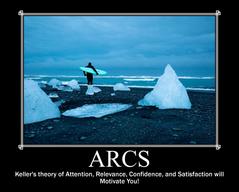Instructional Design Models, Theories & Methodology:
ARCS Model of Motivational Design
 Instruction, even when prepared according to sound instructional design principles, often does not stimulate students' motivation to learn.
Instruction, even when prepared according to sound instructional design principles, often does not stimulate students' motivation to learn.
What Motivates Students to Learn?
Keller's ARCS model of Motivational Learning is a method for improving the motivational appeal of instructional materials.* The model suggests that learning occurs most effectively when learners are engaged throughout the entire learning process, and that strategies can be put in place to ensure that this engagement carries forward through to the completion.
Keller's ARCS method consists of 4 major components:
-
Attention - Material must grab the learner's attention
-
Relevance - Material must matter to them
-
Confidence - Learners must believe that they can succeed
-
Satisfaction - Learner must receive some sort of reward or reinforcement at the end of the learning experience

Attention
Perceptual Arousal
Use specific, relatable examples, create surprise, take a novel approach, use humor if appropriate
Inquiry Arousal
Ask questions, brainstorm, role-play, use hands-on experience
Variability
Incorporate different materials such as web based, video, field trips
Relevance
Goal Orientation
Explain how the lesson will benefit the learner
Motive Matching
Identify the learner's needs and reasons for learning, and give options to accommodate them
Familiarity
Connect the learning to the learner's life, experiences, and values
Confidence
Learning Requirements
Clearly outline what is expected of the students and the criteria for evaluation
Success Opportunities
Give the learner choices and meaningful experiences to help facilitate successful learning
Personal Control
Connect the learning with the student's effort or personal ability
Satisfaction
Intrinsic Reinforcement
Encourage and support the learner's fundamental enjoyment of learning
Extrinsic Reinforcement
Provide positive reinforcement and motivational feedback
Equity
Be consistent, not just within the framework of the assignment, but from one assignment to another
How can this model be used and by whom?
The ARCS model was designed as a global learning model to be effective both in the classroom and in professional learning environments such as corporate training and professional development. The concept is fluid enough that it can be adapted to the level of the learners in the group, and has enough flexibility to be relevant even as the type of learner and the world's learning environments has evolved and changed. In addition, it employs many of the same strategies as those demonstrated in Horton's E-Learning by Deisgn. Horton's demonstration of absorb-type activities such as presentations, falls directly into Keller's category of Perceptual Arousal under the Attention component, and Keller's suggestion of story-telling makes the materials relatable. Moving forward through the model, Horton's Discovery activities, such as role-playing, fall directly under Keller's category of Inquiry Arousal.
Strengths, weaknesses, and similarities to other learning models
There are many similarities between the Keller model and other models of instructional design. Like ADDIE, Dick & Carey, Ross & Kemp, and others, the Keller model begins with its focus on the learner and his outcomes. The most significant difference, however, is that every step in Keller's model continues with the learner in mind, ultimately resulting in positive outcomes because the learner remains engaged throughout the process. Many of the other models abandon concerns about the learner after the initial analysis and assessments have taken place.
Strengths:
- Keeps the learner engaged for the duration of the learning experience
- Is an active learning model that encourages learner participation
- Is flexible and can be incorporated into a wide variety of learning experiences including training, professional development, and classroom regardless of whether the student is in regular ed, special ed, or higher ed
- Continues to be relevant over time
- Easy to apply
Weaknesses
- May require the facilitator to completely re-think his or her approach to instruction
- Presents difficulties if there are learners of different levels of motivation in the group
References
Visser, Jan, Keller, John M. (1990) The clinical use of motivational messages: an inquiry into the validity of the ARCS model of motivational design Instructional Science 19 (6) 467 - 500
Keller, John M (1987) Development of the use of the ARCS modes of instructional design Journal of Instructional Development 10 (3) 2 - 10
Keller, John. "Motivation Design." Official site of John Keller's ARCS Model. Web. 26 July 2011.
<http://www.arcsmodel.com/home.htm>
An Integrated Model of Multimedia Learning and Motivation
Hermann Astleitner; Christian Wiesner, Journal of Educational Multimedia and Hypermedia; 2004; 13, 1; ProQuest Education Journals pg. 3
Contemporary Educational Psychology 25, 54–67 (2000) doi:10.1006/ceps.1999.1020, available online
http://www.psych.rochester.edu/SDT/documents/2000_RyanDeci_IntExtDefs.pdf
